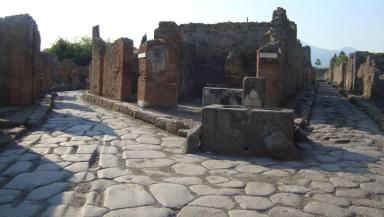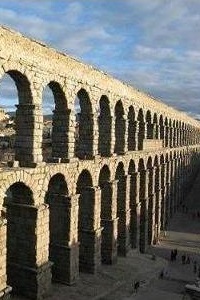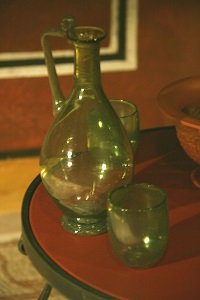Roman roads and Rome's extended road network
Roman roads (viae) were very developed: Rome had an extended road network which stretched from northern England to southern Egypt during the Empire. At its peak, Rome's road network reached a total length of 74,500 miles (or 120,000 km)!Roman roads were quite advanced and reliable for their time. Even during the Middle Ages, there were no better roads being built. They were the most extensive and relied on roads in Europe hundreds of years after the collapse of the Roman Empire and some are still in use today.
Romans would first first set the curb stones, then dig a long pit following a specific trajectory determined by a surveyor. The pit would be filled with a layer of rocks, sand or gravel. This layer would be compacted and another layer of finer gravel would be added. A layer of concrete would then be poured over the rocks and the road would be paved using large polygonal rock slabs. A thinner layer of concrete would be added to make the surface of the road completely flat (the surface was flat and the roads seen today have their surface worn out). This construction made the roads very reliable because roads could resist freezing and flood due to the layer of rocks or gravel below the paved stones. Most importantly, they would last for a very long time and with relatively little maintenance.
The laws of the Twelve Tables (dated circa 450 B.C.) specified that roads should be 8 feet (2.45 meters) wide wherever they were straight and 16 feet wide (4.90 meters) wherever they were curved. Roman roads, especially major roads, went in a straight line and connected two cities often hundreds of kilometers apart, while other important cities along their path were only accessed through branch roads. Roman road construction involved colossal works of engineering due to the roads' length which required massive land excavation and the transport of materials over long distances, and because bridges, tunnels and viaducts had to be built wherever roads encountered major topographical obstacles. Roads were built by the Roman government and would take the name of the censor who built them. However, the maintenance was left to the province and to local magistrates. The landowners were also asked to contribute to the repair of any road passing through their land (usually by paying 50% of the cost).
Many kinds of Roman roads

|
Tolls and way stations
Today roads and infrastructure are built mostly for economic reasons, in order to facilitate the movement of goods and persons. During the Roman times, roads were primarly built for military purposes to allow for the quick movement of legions and to consolidate the newly conquered lands.
Nevertheless, roads played an important economic role by facilitating the movement of goods and persons. Just like our highways today, major roads had tolls. They were often located at bridges or at city gates. Main roads were also used by couriers transporting the equivalent of public mail today with changing stations at regular intervals. Unlike today, the job of carrying mail was dangerous, couriers being often the target of criminals.
Roman roads had way stations or mansiones (meaning "staying places") built by the government at regular intervals usually about 16 to 19 miles apart (25 to 30 kilometers apart). These way stations served drinks and sometimes food. There were the equivalent of our highway rest areas today. However, they often had a bad reputation being often frequented by prostitutes and thieves. Business would generally grow around these mansiones and sometimes small towns would grow around them. Sometimes there would also be a military camp closeby and/or official villas set up only for officials.
Milestones
Roman roads had milestones. Actually the word mile comes from the latin milia passuum which means one thousand paces or 1,480 meters. There were heavy columns placed on a solid rectangular base deep into the ground. They were 5 feet hight (1.50 meters) and 20 inches in diameter (50 centimeters) and each column weighted 2 tons! The number of the mile was indicated at the base of the column. The distance to center of Rome and information about the officials who built and / or repaired the road and when they built it was indicated in the middle of the column. Initially the center of Rome was the Roman Forum but during the reign of Augustus it was considered to be the miliarium aureum (golden milestone) near the temple of Saturn. It was like a bronze monument which indicated the distances to all the major cities of the empire.
Incredible facts about Roman roads
|
SOURCES
- The Oxford Handbook of Engineering and Technology in the Classical World (Oleson, J.P., , Oxford University Press, 2009).
- The roads of Roman Italy: mobility and cultural change (R. Laurence, Routledge, 2002)
- Travel in the Ancient World (L. Casson, Johns Hopkins University Press, 1994)
YOU MAY ALSO LIKE
Return from Roman Roads to Homepage

